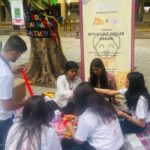Think bamboo mat, and the Japanese tatami rolls out in the blink of an eye. That’s the power of popularity, ubiquity and publicity.
But the lesser-known Kannadippaya mat woven by tribes-folks of the Western Ghats range in Kerala more than meets the eye – mirroring itself in a tessellation of geometric squares and tensile enough to be rolled into a hollowed-out and long bamboo canister of a mere 10cm in diameter.
The squares create an optical illusion that gives the mat its name, a portmanteau of Kannadi, which means “mirror” in Malayalam, and “paya” that translates to mat.
Although not known much outside the southern state, connoisseurs know a Kannadippaya is a royal mat. In the long-ago era of the monarchs, the Kannadippaya in a decorative bamboo cylinder was a gift fit for a king.

Brushed under the carpet for long by a variety of factors, including neglect that breeds through familiarity, efforts are being made now to hard-sell the unique mat and help the hardscrabble weavers with much-needed income. The mat is made almost entirely by women.
Kerala’s own bamboo mat
A Kannadippaya is woven with a specific layer of slivers – the fourth or fifth, which can be made ultra-thin and shiny – split out of a reed bamboo species endemic to the region.
It’s an endangered species, confined to deep forests. Indigenous communities have different names, but it’s better known as Teinostachyum wightii (Munro) Bedd among scientists.
Also Read | Bamboo eliminates poverty among Wayanad villagers
Woven with customary specificities, the mat has a unique sheen and is thin and flexible. There are different weaves, continuous or concentric squares, and based on their arrangement, the designs have names like Pettikannadi, Moolikannadi, Ottakkannan, and Randu Vari.

Patterns are often mixed or the mat’s edges are sometimes embellished with tree and animal motifs.
“Our ancestors learned them by looking at the waves on the streams,” remarked 61-year old Vellapilla Gopi of Vellaramkuthu in Ernakulam district, when asked who taught her the design of Serappaya, a distinctive style. Sera and Chera are derivatives of Thira in Malayalam, which means wave.
Grannies of the Muthuvar, Urali, Mannan, Malayar and Kadar communities know how to weave an authentic Kannadippaya. Ulladar, Malayarayar, and Hill Pulaya communities also weave the mat, but not much.
Living vulnerably on a thin base of livelihood capitals, the tribal communities adopt a mix of options for much-needed income. Bamboo handicraft remains just one among them.
“We used to weave Kannadippaya for our own use and occasionally for community ceremonies,” said 65-year old Kumari paatti (paatti means grandma in Tamil) of a settlement in Idukki.
Until recently, Kannadippaya wasn’t a product traded in the market.
Reed bamboos had myriad applications in indigenous life. For the Muthuvars, the knife used to cut the umbilical cord of a newborn, their agricultural and fishing tools, baskets for storing grains, musical instruments, the comb used for tying the hair at the initiation ceremony of a girl, and even the poles on which the dead are carried for burial had been made of bamboo.

In their modest huts made of bamboo and thatched with reed leaves, they slept on Kannadippaya, which they believe has several health benefits, including warding off rheumatism and back pain.
Forked road to the market
The lure of commercialising Kannadippaya in the modern market, for instance, as a yoga mat, had caught the attention of traders. But there had not been any effort, until recently, to recognize its weavers or organize its production and trade sustainably.
Also Read | The vanishing art of weaving bamboo baskets
Official efforts to form tribal industrial cooperative societies had mostly failed. The Kerala State Bamboo Corporation (KSBC), formed to support bamboo-dependent communities, had promoted only standardised reed mats required for making ply-boards, inadvertently causing an erosion of craft skills among the indigenous people.
New agencies have now stepped in, aware of the challenges in preserving and protecting the skills, and the intellectual property of the tribal women. Kerala Forest Research Institute (KFRI) has facilitated an effort to gain the geographical indication (GI) tag for Kannadippaya.
“The districts of Idukki, Pathanamthitta, Ernakulam,Thrissur and Palakkad and all decorative and utility products using the Kannadi design are covered in the registration application,” said CR Elsy, former coordinator of the Intellectual Property Rights (IPR) Cell of Kerala Agriculture University.

“From extraction of reeds to weaving, it takes two-to-three weeks to finish a single Kannadippaya. A woman independently handles the processes and she should get a premium price,” said AV Raghu, principal scientist at KFRI.
Raghu hopes that the true price for Kannadippaya can be gained through exports.
But the market is also a monster.
“At best, Kannadippaya can be made in small batches and sold as souvenirs to discerning customers who value craft,’’ cautioned ecologist Manju Vasudevan, who strives to sustain the native wisdom of forest-dwelling communities and promote products based on it.
Also Read | Lacking access to bamboo, Basor artisans struggle for livelihood
The lead image at the top shows concentric mirrors on a Kannadippaya (Photo by Surendranath C)
Surendranath C is a journalist and social worker in mainstream print media and with the NGO Uravu that works closely with bamboo artisans.








